Exploring Factors and Strategies for Employee Motivation at Work
VerifiedAdded on 2023/06/15
|10
|2021
|166
Report
AI Summary
This report delves into the multifaceted aspects of employee motivation, highlighting the significance of motivation in achieving organizational goals and fostering a positive professional environment. It examines various factors that motivate employees, such as salary, promotion opportunities, and a conducive work environment. The report also analyzes positive factors like strong colleague relationships, career development, and job security, alongside negative factors like workplace conflict and poor management. Furthermore, it discusses strategies to address these negative factors, including providing opportunities for employees to express their opinions and fostering a culture of respect and trust. The report concludes that a motivated workforce is crucial for sustained growth and development, emphasizing the importance of understanding and addressing the diverse needs and concerns of employees to create a thriving professional context. Desklib offers a wealth of similar solved assignments to aid students in their studies.
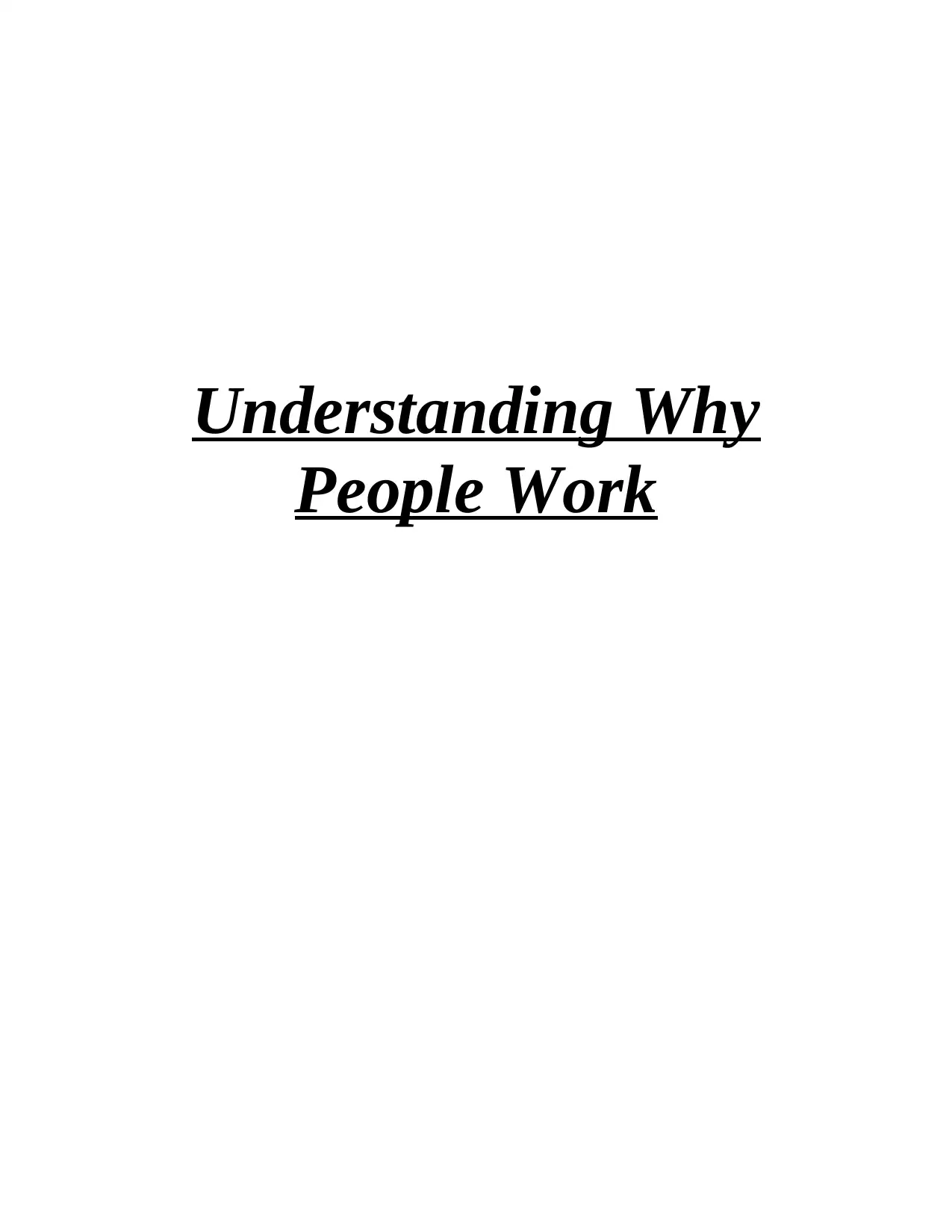
Understanding Why
People Work
People Work
Paraphrase This Document
Need a fresh take? Get an instant paraphrase of this document with our AI Paraphraser
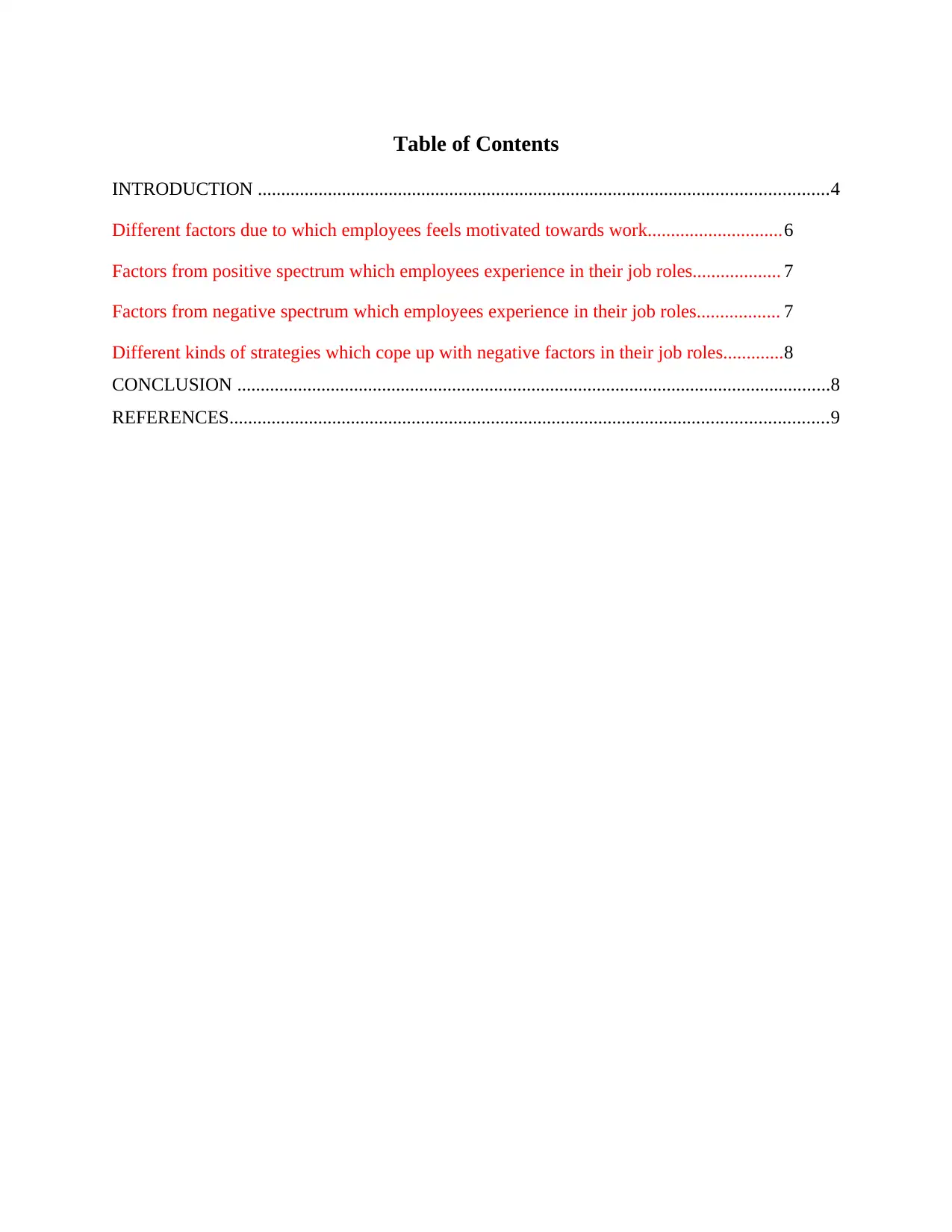
Table of Contents
INTRODUCTION ..........................................................................................................................4
Different factors due to which employees feels motivated towards work.............................6
Factors from positive spectrum which employees experience in their job roles................... 7
Factors from negative spectrum which employees experience in their job roles.................. 7
Different kinds of strategies which cope up with negative factors in their job roles.............8
CONCLUSION ...............................................................................................................................8
REFERENCES................................................................................................................................9
INTRODUCTION ..........................................................................................................................4
Different factors due to which employees feels motivated towards work.............................6
Factors from positive spectrum which employees experience in their job roles................... 7
Factors from negative spectrum which employees experience in their job roles.................. 7
Different kinds of strategies which cope up with negative factors in their job roles.............8
CONCLUSION ...............................................................................................................................8
REFERENCES................................................................................................................................9
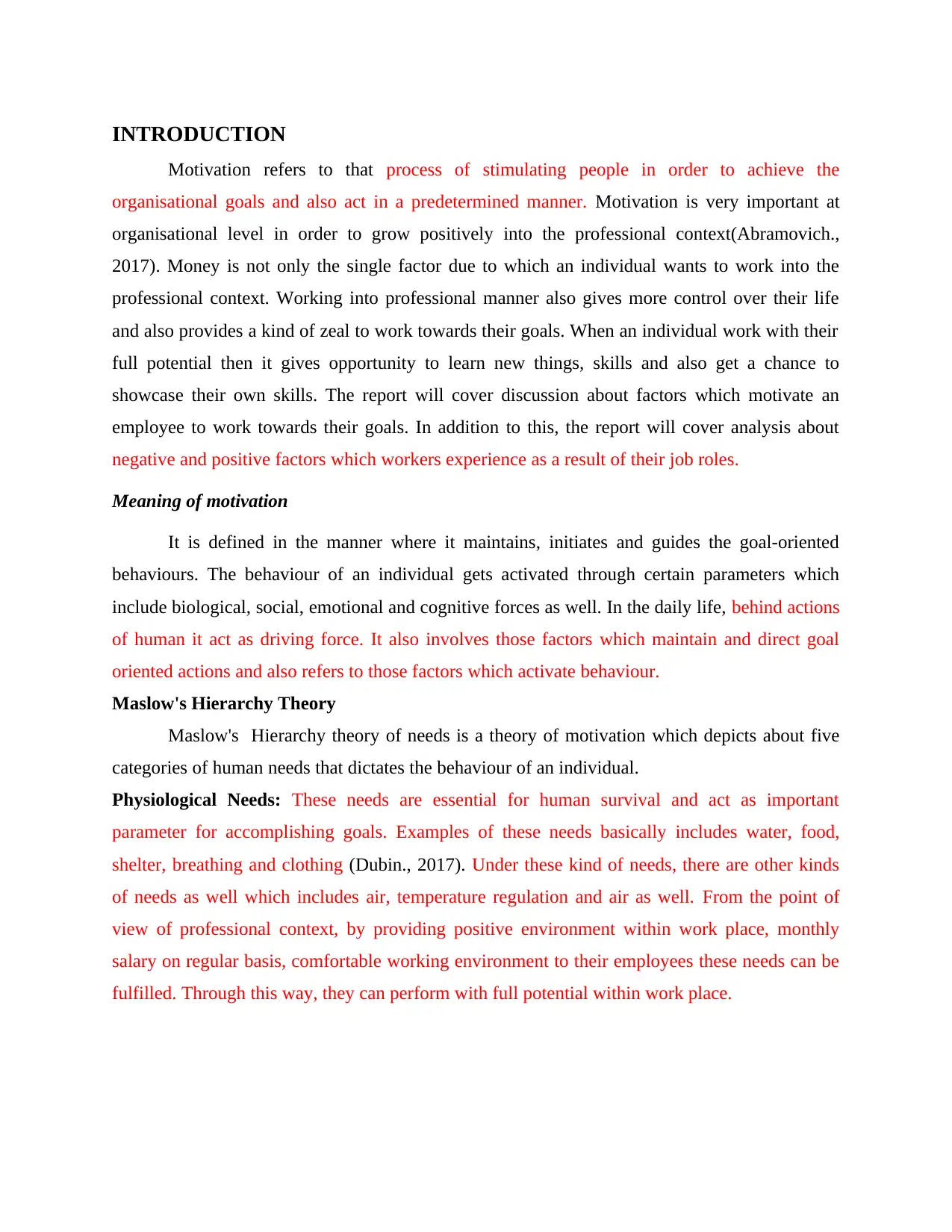
INTRODUCTION
Motivation refers to that process of stimulating people in order to achieve the
organisational goals and also act in a predetermined manner. Motivation is very important at
organisational level in order to grow positively into the professional context(Abramovich.,
2017). Money is not only the single factor due to which an individual wants to work into the
professional context. Working into professional manner also gives more control over their life
and also provides a kind of zeal to work towards their goals. When an individual work with their
full potential then it gives opportunity to learn new things, skills and also get a chance to
showcase their own skills. The report will cover discussion about factors which motivate an
employee to work towards their goals. In addition to this, the report will cover analysis about
negative and positive factors which workers experience as a result of their job roles.
Meaning of motivation
It is defined in the manner where it maintains, initiates and guides the goal-oriented
behaviours. The behaviour of an individual gets activated through certain parameters which
include biological, social, emotional and cognitive forces as well. In the daily life, behind actions
of human it act as driving force. It also involves those factors which maintain and direct goal
oriented actions and also refers to those factors which activate behaviour.
Maslow's Hierarchy Theory
Maslow's Hierarchy theory of needs is a theory of motivation which depicts about five
categories of human needs that dictates the behaviour of an individual.
Physiological Needs: These needs are essential for human survival and act as important
parameter for accomplishing goals. Examples of these needs basically includes water, food,
shelter, breathing and clothing (Dubin., 2017). Under these kind of needs, there are other kinds
of needs as well which includes air, temperature regulation and air as well. From the point of
view of professional context, by providing positive environment within work place, monthly
salary on regular basis, comfortable working environment to their employees these needs can be
fulfilled. Through this way, they can perform with full potential within work place.
Motivation refers to that process of stimulating people in order to achieve the
organisational goals and also act in a predetermined manner. Motivation is very important at
organisational level in order to grow positively into the professional context(Abramovich.,
2017). Money is not only the single factor due to which an individual wants to work into the
professional context. Working into professional manner also gives more control over their life
and also provides a kind of zeal to work towards their goals. When an individual work with their
full potential then it gives opportunity to learn new things, skills and also get a chance to
showcase their own skills. The report will cover discussion about factors which motivate an
employee to work towards their goals. In addition to this, the report will cover analysis about
negative and positive factors which workers experience as a result of their job roles.
Meaning of motivation
It is defined in the manner where it maintains, initiates and guides the goal-oriented
behaviours. The behaviour of an individual gets activated through certain parameters which
include biological, social, emotional and cognitive forces as well. In the daily life, behind actions
of human it act as driving force. It also involves those factors which maintain and direct goal
oriented actions and also refers to those factors which activate behaviour.
Maslow's Hierarchy Theory
Maslow's Hierarchy theory of needs is a theory of motivation which depicts about five
categories of human needs that dictates the behaviour of an individual.
Physiological Needs: These needs are essential for human survival and act as important
parameter for accomplishing goals. Examples of these needs basically includes water, food,
shelter, breathing and clothing (Dubin., 2017). Under these kind of needs, there are other kinds
of needs as well which includes air, temperature regulation and air as well. From the point of
view of professional context, by providing positive environment within work place, monthly
salary on regular basis, comfortable working environment to their employees these needs can be
fulfilled. Through this way, they can perform with full potential within work place.
⊘ This is a preview!⊘
Do you want full access?
Subscribe today to unlock all pages.

Trusted by 1+ million students worldwide
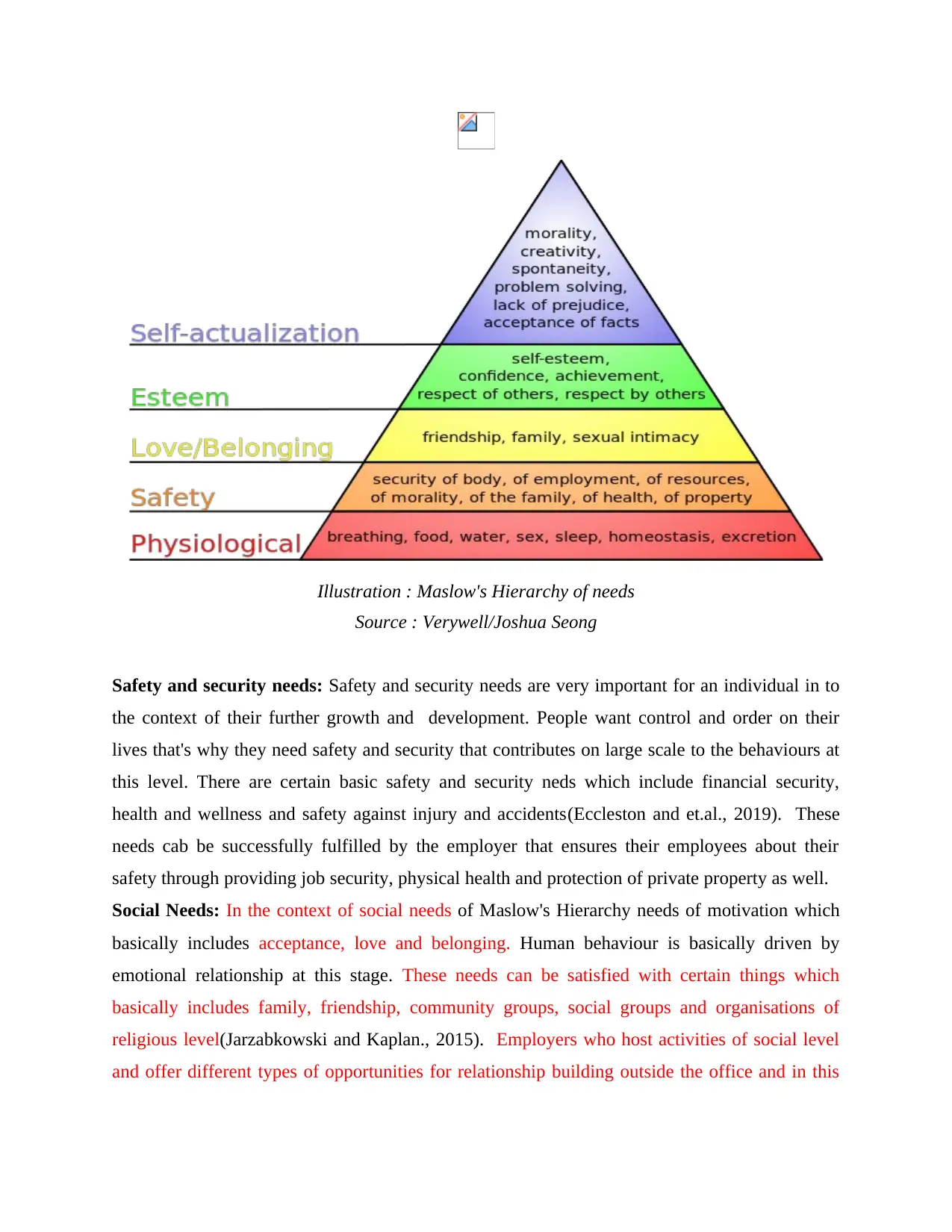
Illustration : Maslow's Hierarchy of needs
Source : Verywell/Joshua Seong
Safety and security needs: Safety and security needs are very important for an individual in to
the context of their further growth and development. People want control and order on their
lives that's why they need safety and security that contributes on large scale to the behaviours at
this level. There are certain basic safety and security neds which include financial security,
health and wellness and safety against injury and accidents(Eccleston and et.al., 2019). These
needs cab be successfully fulfilled by the employer that ensures their employees about their
safety through providing job security, physical health and protection of private property as well.
Social Needs: In the context of social needs of Maslow's Hierarchy needs of motivation which
basically includes acceptance, love and belonging. Human behaviour is basically driven by
emotional relationship at this stage. These needs can be satisfied with certain things which
basically includes family, friendship, community groups, social groups and organisations of
religious level(Jarzabkowski and Kaplan., 2015). Employers who host activities of social level
and offer different types of opportunities for relationship building outside the office and in this
Source : Verywell/Joshua Seong
Safety and security needs: Safety and security needs are very important for an individual in to
the context of their further growth and development. People want control and order on their
lives that's why they need safety and security that contributes on large scale to the behaviours at
this level. There are certain basic safety and security neds which include financial security,
health and wellness and safety against injury and accidents(Eccleston and et.al., 2019). These
needs cab be successfully fulfilled by the employer that ensures their employees about their
safety through providing job security, physical health and protection of private property as well.
Social Needs: In the context of social needs of Maslow's Hierarchy needs of motivation which
basically includes acceptance, love and belonging. Human behaviour is basically driven by
emotional relationship at this stage. These needs can be satisfied with certain things which
basically includes family, friendship, community groups, social groups and organisations of
religious level(Jarzabkowski and Kaplan., 2015). Employers who host activities of social level
and offer different types of opportunities for relationship building outside the office and in this
Paraphrase This Document
Need a fresh take? Get an instant paraphrase of this document with our AI Paraphraser
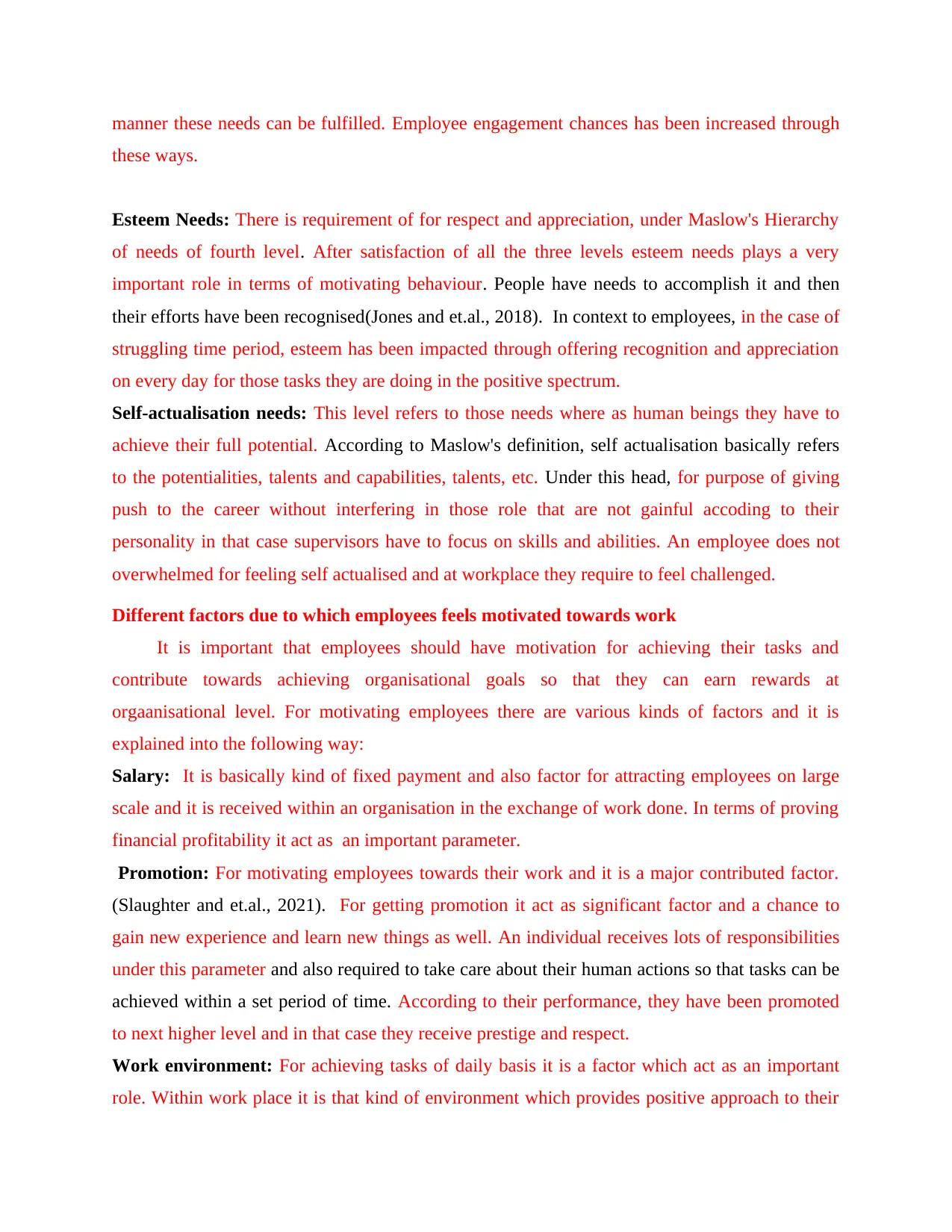
manner these needs can be fulfilled. Employee engagement chances has been increased through
these ways.
Esteem Needs: There is requirement of for respect and appreciation, under Maslow's Hierarchy
of needs of fourth level. After satisfaction of all the three levels esteem needs plays a very
important role in terms of motivating behaviour. People have needs to accomplish it and then
their efforts have been recognised(Jones and et.al., 2018). In context to employees, in the case of
struggling time period, esteem has been impacted through offering recognition and appreciation
on every day for those tasks they are doing in the positive spectrum.
Self-actualisation needs: This level refers to those needs where as human beings they have to
achieve their full potential. According to Maslow's definition, self actualisation basically refers
to the potentialities, talents and capabilities, talents, etc. Under this head, for purpose of giving
push to the career without interfering in those role that are not gainful accoding to their
personality in that case supervisors have to focus on skills and abilities. An employee does not
overwhelmed for feeling self actualised and at workplace they require to feel challenged.
Different factors due to which employees feels motivated towards work
It is important that employees should have motivation for achieving their tasks and
contribute towards achieving organisational goals so that they can earn rewards at
orgaanisational level. For motivating employees there are various kinds of factors and it is
explained into the following way:
Salary: It is basically kind of fixed payment and also factor for attracting employees on large
scale and it is received within an organisation in the exchange of work done. In terms of proving
financial profitability it act as an important parameter.
Promotion: For motivating employees towards their work and it is a major contributed factor.
(Slaughter and et.al., 2021). For getting promotion it act as significant factor and a chance to
gain new experience and learn new things as well. An individual receives lots of responsibilities
under this parameter and also required to take care about their human actions so that tasks can be
achieved within a set period of time. According to their performance, they have been promoted
to next higher level and in that case they receive prestige and respect.
Work environment: For achieving tasks of daily basis it is a factor which act as an important
role. Within work place it is that kind of environment which provides positive approach to their
these ways.
Esteem Needs: There is requirement of for respect and appreciation, under Maslow's Hierarchy
of needs of fourth level. After satisfaction of all the three levels esteem needs plays a very
important role in terms of motivating behaviour. People have needs to accomplish it and then
their efforts have been recognised(Jones and et.al., 2018). In context to employees, in the case of
struggling time period, esteem has been impacted through offering recognition and appreciation
on every day for those tasks they are doing in the positive spectrum.
Self-actualisation needs: This level refers to those needs where as human beings they have to
achieve their full potential. According to Maslow's definition, self actualisation basically refers
to the potentialities, talents and capabilities, talents, etc. Under this head, for purpose of giving
push to the career without interfering in those role that are not gainful accoding to their
personality in that case supervisors have to focus on skills and abilities. An employee does not
overwhelmed for feeling self actualised and at workplace they require to feel challenged.
Different factors due to which employees feels motivated towards work
It is important that employees should have motivation for achieving their tasks and
contribute towards achieving organisational goals so that they can earn rewards at
orgaanisational level. For motivating employees there are various kinds of factors and it is
explained into the following way:
Salary: It is basically kind of fixed payment and also factor for attracting employees on large
scale and it is received within an organisation in the exchange of work done. In terms of proving
financial profitability it act as an important parameter.
Promotion: For motivating employees towards their work and it is a major contributed factor.
(Slaughter and et.al., 2021). For getting promotion it act as significant factor and a chance to
gain new experience and learn new things as well. An individual receives lots of responsibilities
under this parameter and also required to take care about their human actions so that tasks can be
achieved within a set period of time. According to their performance, they have been promoted
to next higher level and in that case they receive prestige and respect.
Work environment: For achieving tasks of daily basis it is a factor which act as an important
role. Within work place it is that kind of environment which provides positive approach to their
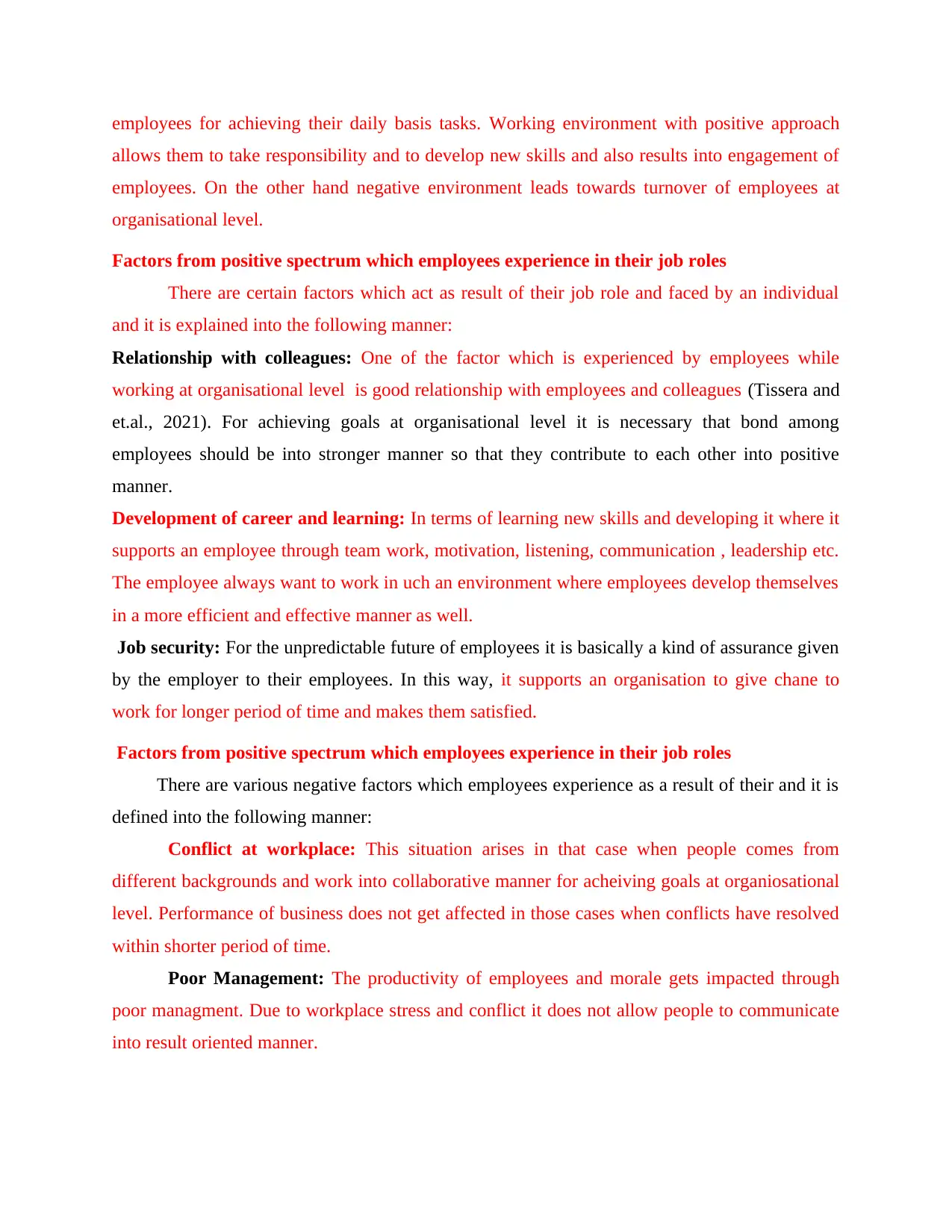
employees for achieving their daily basis tasks. Working environment with positive approach
allows them to take responsibility and to develop new skills and also results into engagement of
employees. On the other hand negative environment leads towards turnover of employees at
organisational level.
Factors from positive spectrum which employees experience in their job roles
There are certain factors which act as result of their job role and faced by an individual
and it is explained into the following manner:
Relationship with colleagues: One of the factor which is experienced by employees while
working at organisational level is good relationship with employees and colleagues (Tissera and
et.al., 2021). For achieving goals at organisational level it is necessary that bond among
employees should be into stronger manner so that they contribute to each other into positive
manner.
Development of career and learning: In terms of learning new skills and developing it where it
supports an employee through team work, motivation, listening, communication , leadership etc.
The employee always want to work in uch an environment where employees develop themselves
in a more efficient and effective manner as well.
Job security: For the unpredictable future of employees it is basically a kind of assurance given
by the employer to their employees. In this way, it supports an organisation to give chane to
work for longer period of time and makes them satisfied.
Factors from positive spectrum which employees experience in their job roles
There are various negative factors which employees experience as a result of their and it is
defined into the following manner:
Conflict at workplace: This situation arises in that case when people comes from
different backgrounds and work into collaborative manner for acheiving goals at organiosational
level. Performance of business does not get affected in those cases when conflicts have resolved
within shorter period of time.
Poor Management: The productivity of employees and morale gets impacted through
poor managment. Due to workplace stress and conflict it does not allow people to communicate
into result oriented manner.
allows them to take responsibility and to develop new skills and also results into engagement of
employees. On the other hand negative environment leads towards turnover of employees at
organisational level.
Factors from positive spectrum which employees experience in their job roles
There are certain factors which act as result of their job role and faced by an individual
and it is explained into the following manner:
Relationship with colleagues: One of the factor which is experienced by employees while
working at organisational level is good relationship with employees and colleagues (Tissera and
et.al., 2021). For achieving goals at organisational level it is necessary that bond among
employees should be into stronger manner so that they contribute to each other into positive
manner.
Development of career and learning: In terms of learning new skills and developing it where it
supports an employee through team work, motivation, listening, communication , leadership etc.
The employee always want to work in uch an environment where employees develop themselves
in a more efficient and effective manner as well.
Job security: For the unpredictable future of employees it is basically a kind of assurance given
by the employer to their employees. In this way, it supports an organisation to give chane to
work for longer period of time and makes them satisfied.
Factors from positive spectrum which employees experience in their job roles
There are various negative factors which employees experience as a result of their and it is
defined into the following manner:
Conflict at workplace: This situation arises in that case when people comes from
different backgrounds and work into collaborative manner for acheiving goals at organiosational
level. Performance of business does not get affected in those cases when conflicts have resolved
within shorter period of time.
Poor Management: The productivity of employees and morale gets impacted through
poor managment. Due to workplace stress and conflict it does not allow people to communicate
into result oriented manner.
⊘ This is a preview!⊘
Do you want full access?
Subscribe today to unlock all pages.

Trusted by 1+ million students worldwide
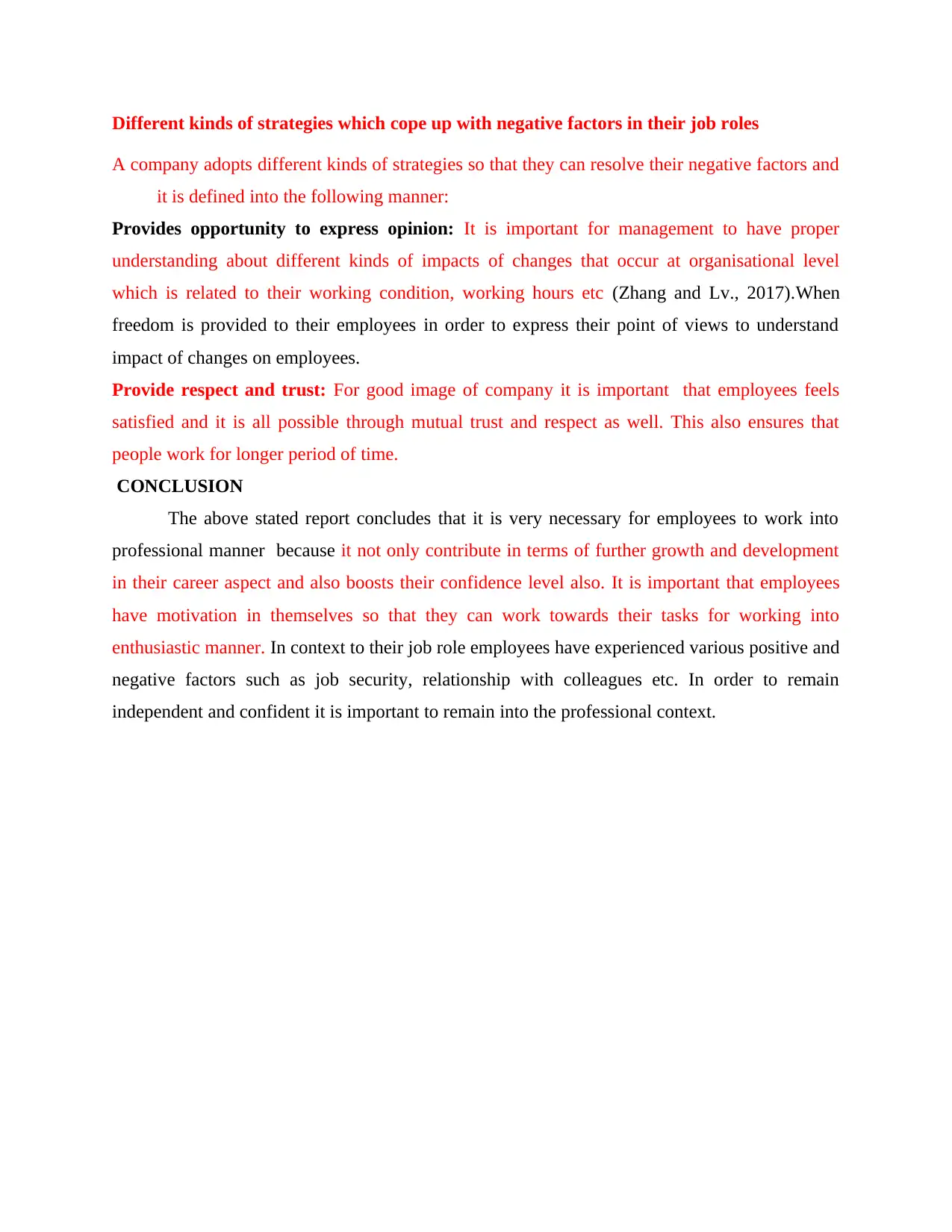
Different kinds of strategies which cope up with negative factors in their job roles
A company adopts different kinds of strategies so that they can resolve their negative factors and
it is defined into the following manner:
Provides opportunity to express opinion: It is important for management to have proper
understanding about different kinds of impacts of changes that occur at organisational level
which is related to their working condition, working hours etc (Zhang and Lv., 2017).When
freedom is provided to their employees in order to express their point of views to understand
impact of changes on employees.
Provide respect and trust: For good image of company it is important that employees feels
satisfied and it is all possible through mutual trust and respect as well. This also ensures that
people work for longer period of time.
CONCLUSION
The above stated report concludes that it is very necessary for employees to work into
professional manner because it not only contribute in terms of further growth and development
in their career aspect and also boosts their confidence level also. It is important that employees
have motivation in themselves so that they can work towards their tasks for working into
enthusiastic manner. In context to their job role employees have experienced various positive and
negative factors such as job security, relationship with colleagues etc. In order to remain
independent and confident it is important to remain into the professional context.
A company adopts different kinds of strategies so that they can resolve their negative factors and
it is defined into the following manner:
Provides opportunity to express opinion: It is important for management to have proper
understanding about different kinds of impacts of changes that occur at organisational level
which is related to their working condition, working hours etc (Zhang and Lv., 2017).When
freedom is provided to their employees in order to express their point of views to understand
impact of changes on employees.
Provide respect and trust: For good image of company it is important that employees feels
satisfied and it is all possible through mutual trust and respect as well. This also ensures that
people work for longer period of time.
CONCLUSION
The above stated report concludes that it is very necessary for employees to work into
professional manner because it not only contribute in terms of further growth and development
in their career aspect and also boosts their confidence level also. It is important that employees
have motivation in themselves so that they can work towards their tasks for working into
enthusiastic manner. In context to their job role employees have experienced various positive and
negative factors such as job security, relationship with colleagues etc. In order to remain
independent and confident it is important to remain into the professional context.
Paraphrase This Document
Need a fresh take? Get an instant paraphrase of this document with our AI Paraphraser
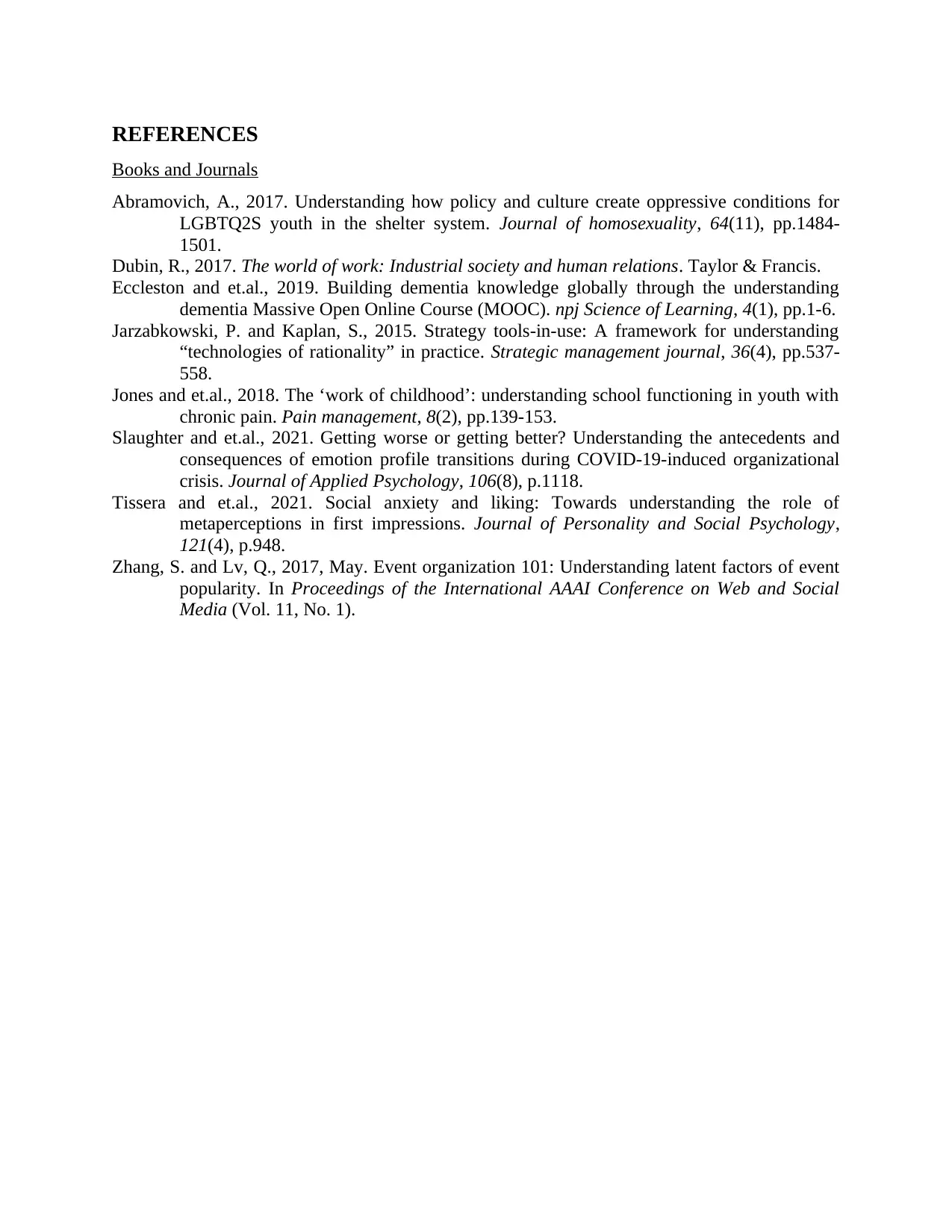
REFERENCES
Books and Journals
Abramovich, A., 2017. Understanding how policy and culture create oppressive conditions for
LGBTQ2S youth in the shelter system. Journal of homosexuality, 64(11), pp.1484-
1501.
Dubin, R., 2017. The world of work: Industrial society and human relations. Taylor & Francis.
Eccleston and et.al., 2019. Building dementia knowledge globally through the understanding
dementia Massive Open Online Course (MOOC). npj Science of Learning, 4(1), pp.1-6.
Jarzabkowski, P. and Kaplan, S., 2015. Strategy tools‐in‐use: A framework for understanding
“technologies of rationality” in practice. Strategic management journal, 36(4), pp.537-
558.
Jones and et.al., 2018. The ‘work of childhood’: understanding school functioning in youth with
chronic pain. Pain management, 8(2), pp.139-153.
Slaughter and et.al., 2021. Getting worse or getting better? Understanding the antecedents and
consequences of emotion profile transitions during COVID-19-induced organizational
crisis. Journal of Applied Psychology, 106(8), p.1118.
Tissera and et.al., 2021. Social anxiety and liking: Towards understanding the role of
metaperceptions in first impressions. Journal of Personality and Social Psychology,
121(4), p.948.
Zhang, S. and Lv, Q., 2017, May. Event organization 101: Understanding latent factors of event
popularity. In Proceedings of the International AAAI Conference on Web and Social
Media (Vol. 11, No. 1).
Books and Journals
Abramovich, A., 2017. Understanding how policy and culture create oppressive conditions for
LGBTQ2S youth in the shelter system. Journal of homosexuality, 64(11), pp.1484-
1501.
Dubin, R., 2017. The world of work: Industrial society and human relations. Taylor & Francis.
Eccleston and et.al., 2019. Building dementia knowledge globally through the understanding
dementia Massive Open Online Course (MOOC). npj Science of Learning, 4(1), pp.1-6.
Jarzabkowski, P. and Kaplan, S., 2015. Strategy tools‐in‐use: A framework for understanding
“technologies of rationality” in practice. Strategic management journal, 36(4), pp.537-
558.
Jones and et.al., 2018. The ‘work of childhood’: understanding school functioning in youth with
chronic pain. Pain management, 8(2), pp.139-153.
Slaughter and et.al., 2021. Getting worse or getting better? Understanding the antecedents and
consequences of emotion profile transitions during COVID-19-induced organizational
crisis. Journal of Applied Psychology, 106(8), p.1118.
Tissera and et.al., 2021. Social anxiety and liking: Towards understanding the role of
metaperceptions in first impressions. Journal of Personality and Social Psychology,
121(4), p.948.
Zhang, S. and Lv, Q., 2017, May. Event organization 101: Understanding latent factors of event
popularity. In Proceedings of the International AAAI Conference on Web and Social
Media (Vol. 11, No. 1).

⊘ This is a preview!⊘
Do you want full access?
Subscribe today to unlock all pages.

Trusted by 1+ million students worldwide

1 out of 10
Related Documents
Your All-in-One AI-Powered Toolkit for Academic Success.
+13062052269
info@desklib.com
Available 24*7 on WhatsApp / Email
![[object Object]](/_next/static/media/star-bottom.7253800d.svg)
Unlock your academic potential
Copyright © 2020–2025 A2Z Services. All Rights Reserved. Developed and managed by ZUCOL.



